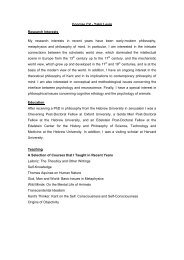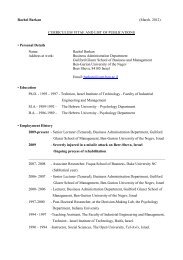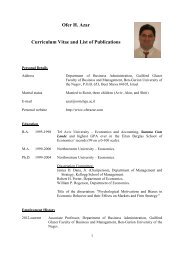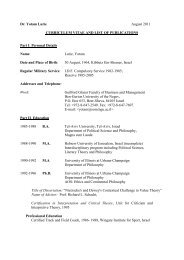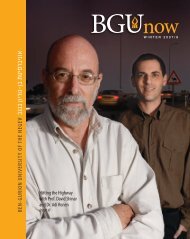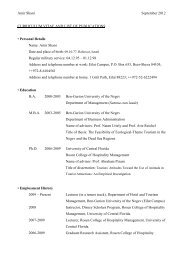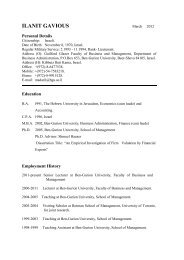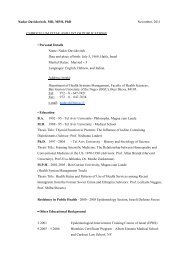cover 2006
cover 2006
cover 2006
Create successful ePaper yourself
Turn your PDF publications into a flip-book with our unique Google optimized e-Paper software.
Dr. Nadya Gurevich<br />
Fitting The Pieces Together<br />
46 BGU NOW<br />
O<br />
f all the things you might not<br />
expect to see in a Russian-born<br />
Israeli mathematician’s office is<br />
commentary from Calvin & Hobbs,<br />
but there it is: an American cartoon,<br />
featuring the tousle-headed kid<br />
engaged in a philosophical debate<br />
with his father, exploring the balance<br />
between teamwork and<br />
individuality.<br />
Mathematical theorists like<br />
Dr. Nadya Gurevich of the<br />
Department of Mathematics – who<br />
is already a rising star in the field of<br />
automorphic forms – seek balance.<br />
Individually, they are a small, lofty<br />
group of individuals around the<br />
world who frequently work alone,<br />
laboring over problems most of the<br />
rest of us didn’t know existed, yet<br />
find satisfaction in sharing both<br />
projects and results.<br />
“What fascinates me in math is<br />
exploring the relationship between<br />
things,” Gurevich says with a<br />
twinkle, “when things from two<br />
different fields meet and I find that<br />
a method I used in one problem also<br />
works in another.”<br />
If that sounds terribly abstract, it<br />
is. The pursuit of pure math –<br />
applying theoretical concepts to<br />
abstract problems, searching for<br />
answers that may not have any<br />
immediate practical application at<br />
all – isn’t for everyone. But for<br />
Gurevich, the hours spent pouring<br />
over problems so complex that they<br />
can’t even be explained to math<br />
amateurs, the process is satisfying.<br />
Every now and then she sees results<br />
and that makes all the effort<br />
worthwhile.<br />
Born in Russia in 1974, Gurevich<br />
made aliyah when she was 15 years<br />
old. With an undergraduate degree<br />
in mathematics summa cum laude<br />
from Tel Aviv University, she went<br />
on to receive her Ph.D. from the<br />
Weizmann Institute of Science,<br />
winning grants and prizes for<br />
excellence all along the way,<br />
including most recently a sizeable<br />
grant from the Israel Science<br />
Foundation.<br />
From 2000-2003, Gurevich was a<br />
Veblen Research Instructor at<br />
Princeton University and the<br />
Institute of Advanced Studies. “I was<br />
determined to come back to Israel,”<br />
she says. “But I enjoyed the work<br />
that I did at Princeton. I was invited<br />
to BGU to give a talk and was really<br />
impressed by the opportunities I<br />
saw. When I was offered a position<br />
at BGU, I accepted. I didn’t really<br />
think about any other place.”<br />
Gurevich’s fascination with math<br />
began when she joined a Math Circle<br />
– an extra-curricular math club –<br />
when she was about 11 years old. “I<br />
liked the math,” she says, “but the<br />
way the teachers presented it was a<br />
large part of the attraction. They<br />
didn’t stuff us with facts; instead,<br />
they found ways to give us<br />
interesting problems, to inspire us<br />
to find non-standard solutions. I was<br />
fascinated. In my other classes, it<br />
was very rare that something would<br />
make me say ‘Wow!’ But in Math<br />
Circle, there were lots of ‘wow’<br />
experiences. I’d see how some piece<br />
of information fit into a problem in<br />
a new way – it was a delight.”<br />
Finding a way to explain what<br />
Gurevich actually does isn’t easy for<br />
those whose math skills stop at the<br />
basics. Gurevich’s specialty lies in<br />
“automorphic forms,” which was<br />
invented to solve problems in<br />
number theory, one of the oldest in<br />
mathematics. Work in automorphic<br />
forms combines ideas from algebra,<br />
geometry and analysis, which is why<br />
Gurevich says it’s so powerful.<br />
Success in her field results from a<br />
combination of both individual and<br />
team work, Gurevich says. One of<br />
her early successes was in a<br />
collaborative effort where she and<br />
two colleagues explored a piece of<br />
mathematical “folklore.” “‘Folklore’<br />
is something that is thought to be<br />
true,” she says, “not because anyone<br />
has actually studied it or proved it,<br />
but just because it’s commonly<br />
accepted.<br />
“We were working on one of those<br />
common assumptions. It wasn’t a<br />
huge, earthshaking thing, but when<br />
We seek out the unknown. We try to establish<br />
the relationships between things. We strive to<br />
pin down knowledge no one had before<br />
we disproved it, it surprised even<br />
us; it was very satisfying. Of course,<br />
we checked it over and over and<br />
then we asked others to check it as<br />
well. There was general agreement<br />
that we were right.”<br />
Gurevich presented their work at<br />
a conference in Israel in 2001. “There<br />
were several responses and<br />
ultimately, general assent that we<br />
were right, so we sent it on to more



